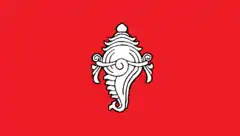Vanchi Bhumi
Vanchi Bhumi (alternatively Vanji Bhumi) is the national anthem of the ertswhile Kingdom of Travancore which now forms part of Kerala. It was formally known as the Vanchishamangalam meaning "Hail the Lord of Vanchi". It was played by the Travancore radio every night as the last item.[1]
| English: The Lord of Vanchi | |
|---|---|
 Flag of the Kingdom of Travancore | |
National anthem of Travancore | |
| Relinquished | 1947 |
Vanchi Bhumi, meaning the "Land of Vanchi", is a reference to the city of Thiruvanchikulam, Kodungallur the capital of the Later Cheras, and the "Lord of Vanchi", the Later Chera's tutelary deity, Vanchinathan, a name for Hindu god Shiva.
Written in Malayalam language, it was the anthem of the Kingdom of Travancore until 1947, and the merger of Kingdom of Travancore with India.[2]
The anthem ran thus:
Vanchi Bhumi (Malayalam)
- വഞ്ചിഭൂമിപതേ ചിരം
- സഞ്ജിതാഭം ജയിക്കേണം
- ദേവദേവൻ ഭവാനെന്നും
- ദേഹസൗഖ്യം വളർത്തേണം
- വഞ്ചിഭൂമിപതേ ചിരം
- ത്വച്ചരിതമെന്നും ഭൂമൗ
- വിശൃതമായി വിളങ്ങേണം
- വഞ്ചിഭൂമിപതേ ചിരം
- മർത്യമനമേതും ഭവാൽ
- പത്തനമായി ഭവിക്കേണം
- വഞ്ചിഭൂമിപതേ ചിരം
- താവകമാം കുലം മേന്മേൽ
- ശ്രീവളർന്നുല്ലസിക്കേണം
- വഞ്ചിഭൂമിപതേ ചിരം
- മാലകറ്റി ചിരം
- പ്രജാപാലനം ചെയ്തരുളേണം
- വഞ്ചിഭൂമിപതേ ചിരം
- സഞ്ജിതാഭം ജയിക്കേണം.
Vanchi Bhumi (Romanization)
- vañcibhūmipatē ciraṁ
- sañjitābhaṁ jayikkēṇaṁ
- dēvadēvan bhavānennuṁ
- dēhasakhyaṁ vaḷarttēṇaṁ
- vañcibhūmipatē ciraṁ
- tvaccaritamennuṁ bhūmau
- viśr̥tamāyi viḷaṅgēṇaṁ
- vañcibhūmipatē ciraṁ
- martyamanamētuṁ bhavāl
- pattanamāyi bhavikkēṇaṁ
- vañcibhūmipatē ciraṁ
- tāvakamāṁ kulaṁ mēnmēl
- śrīvaḷarnnullasikkēṇaṁ
- vañcibhūmipatē ciraṁ
- mālakaṟṟi ciraṁ
- prajāpālanaṁ ceytaruḷēṇaṁ
- vañcibhūmipatē ciraṁ
- sañjitābhaṁ jayikkēṇaṁ.
Vanchi Bhumi (Translation)
- O Lord of Vanchi Land!
- Thou should hail forever, most gloriously!
- The God of gods*, the Lord*, daily
- Shall promote our physical well-being!
- Thy legend , in earth, daily,
- Should be famous and glorified;
- All of the human minds
- Should be thy abode;
- The family of thine (subjects)
- Should prosper graciously.
- Evading the sadness, forever
- Thou should protect the subjects.